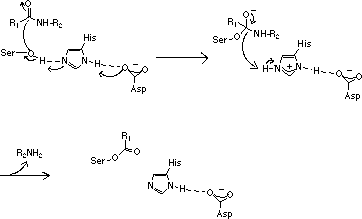The proteolytic mechanism of serine proteases
The bond-cleaving reaction exerted by a serine protease on its substrate is the result of an interaction between the substrate and the charge relay network of the enzyme.
This network, which is present in the active site of all serine proteases, is known as the catalytic triad.
It is built up from the side-chains of three specific amino acids (the hydroxy group of serine, the imidazole group of histidine and the carboxylic acid group of aspartic acid) that interact with each other through an array of hydrogen bonds.
 Figure 1. Charge relay network of serine proteases.
Figure 1. Charge relay network of serine proteases.
The proteolytic action of a serine protease on its substrate comprises several steps starting with the formation of a non-covalent complex between the enzyme and the substrate. A nucleophilic attack by the serine hydroxyl group on the amide carbonyl carbon atom in the substrate results in cleavage of the amide bond and the formation of an acyl-enzyme intermediate.
 Figure 2. Formation of an acyl-enzyme intermediate.
Figure 2. Formation of an acyl-enzyme intermediate.
The acyl-enzyme ester bond is then hydrolyzed in the rate limiting step and the enzyme is now free to catalyze the cleavage of another substrate molecule.
 Figure 3. Hydrolysis of the acyl-enzyme intermediate.
Figure 3. Hydrolysis of the acyl-enzyme intermediate.
